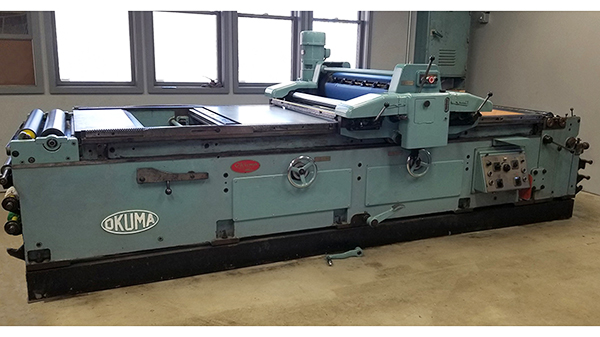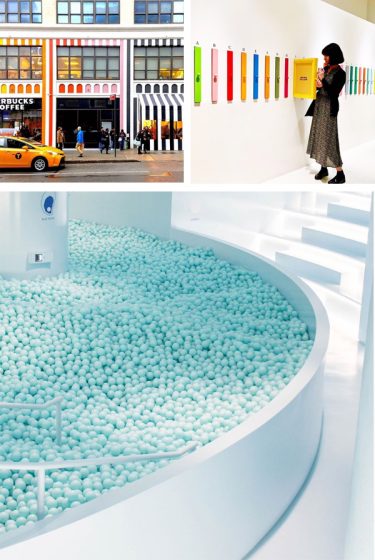At Boxcar we enjoy the tales and trials shared by printers as they tackle a new project or skill. We feel like we are right along with them (cheering) as they figure out each step, particularly when we can be a small part of the process. And we love when someone sends us the final fruits of their labors. You are our heroes and we’d like to introduce to you one pressman who explored Book Printing. In his own words, meet Dale Raby.


A little bit about me – Ampersand Storybooks produces primarily small single-signature books, written by myself, though we may soon be branching out to begin printing stuff written by others. Our usual fare is serialized runs of just over a hundred impressions.


I have been writing for a few years now. My first novel, The Wives of Jacob, Book I, In the Beginning, was and is only available as an ebook. Now, while most of the customers at my day job were impressed that I had written even one book, let alone three, they were decidedly non-plussed when they found out that my books were only collections of pixels, not “real” books.
I investigated the possibility of getting my work printed into “real” books, but like most beginning writers, I lacked the capital.
Having had a brief introduction to letterpress printing some fifty-odd years ago, I did think about the possibility of a hand-operated tabletop platen press, if I could find one somewhere. I did a little checking and discovered that most presses suitable for this kind of project were also beyond my means.
One day I met a man who was a printer and happened to have an old Craftsmen Superior for sale. A price was named and the deal was done. Three weeks later we moved the press from his pickup truck to mine. Now, like most semi-discarded platen presses, it needed some work, but eventually I was able to start making impressions.
At first I used standard copy paper to print things like receipt templates. Then I went to a local office supply store and ordered a quantity of business cards with nothing printed on them. By the next week, I had some usable business cards, though they were not as flashy as “professional” cards.
I started to frequent Briar Press and Ladies of Letterpress among other locales on the web. I exchanged countless emails with the folks at Boxcar Press, picking the brains of many people there. I’m pretty sure that somebody there must’ve drawn the short straw there every time I got a response to an email! I discovered the magic of photopolymer plates and the Boxcar Base. I gradually acquired more movable type fonts, a couple of line gauges and assorted other items of printer’s paraphernalia. I took a rare day off from work and visited the Hamilton Wood Type Museum in Two Rivers, Wisconsin, which was a very educational trip. Eventually, the dining room became the print shop. I still had much to learn, but by gosh, I was a printer of sorts!

I thought that for my first “real” book project, I would do a single-signature book. The Sasquatch’s Dilemma has only seven pages. The first page is my title page and is not numbered. I decided right away that I wanted my books printed on some good stuff, not copy paper. I did some investigating, got a few swatch books and eventually discovered Flurry paper – a 100% cotton paper.
As Flurry was associated with Boxcar Press, who would be making my plates, I decided that this was a good choice. I did have some concerns at first. I was afraid that the text-weight paper would be too thin and the ink would bleed through it. My initial fears proved unfounded.

The pages are printed upon Flurry cotton text-weight paper and the book covers are made from Flurry 118# pre-scored blank cards. I use a three-hole pamphlet stitch with tails on the outside of the cover for binding. Each book comes in its own envelope, which was designed to fit the card that forms the cover. I plan to continue using the envelope as long as the book is thin enough to fit.
Did I mention I had a lot to learn? There was the question of format. I hit upon the idea of using a pre-scored greeting card as a book cover quite early on. The only thing then was to determine the optimal size. I gave myself headaches learning about paper grain and the proper use of a bone folder. I developed a jig for binding my books. The stitching jig did not look like much, but it worked. After much consideration I decided upon the Flurry 10.5” x 7.25” greeting card. The pages could be cut to 7” x 10” for a folded size of 5” x 7” out of the Flurry text-weight paper. This would give a nice cover overlap such as a hard-cover book might have.
I resurrected an old photo trimmer from my film photography days and learned to trim my pages a few at a time, keeping the scraps to be used eventually for business cards for myself and a couple of other local businesses. The text-weight paper is not really optimal for business cards, but it gets the job done.

Kim and Diane, known as “the Copy Editors” badgered me about various things that were decidedly outside the traditional purview of copy editors. Kim was relentless, and not above using a hammer to get things into my head, so I learned a few more things. I did mention I had a lot to learn, didn’t I? Under Kim’s tutelage, I became familiar with terms like “small caps”, “drop caps”, “orphans” & “widows”. At the time Kim was busy with college but continued to educate me. Kim has since graduated and now works in a print shop… which I think is pretty groovy!
I found many free type fonts out there on the web along with images for my cover image. As most of them were intended primarily for either HTML documents on the web or inkjet printers, not all of them were suitable. Naked Chicks didn’t make the cut as Diane hated it. Kim nixed Comic Sans as “The Devil’s Font”. Crimson Text (now Crimson Pro), Alice, Black Chancery and Typographer Woodcut were all incorporated into The Sasquatch’s Dilemma.
When it came time to order plates, Kim showed me some of her poetry. Shortly thereafter, Ocean Creature was hastily assembled into a second single-signature book manuscript. Both were submitted to Boxcar Press as PDF’s and converted into plates.
Upon receipt of my polymer plates, I started learning about how to correctly assemble the leaves into pages for my book. For those of you who have never assembled a book before, well, suffice to say that it is not quite like one of those books you might have made in first grade bound with an office stapler. I used the proofs provided to assemble a dummy book so I could be sure of printing my books correctly.

When it came time to print, I had to learn how to properly set up and ink the press. Proper inking and roller clearance was fairly important when printing those Typographer Woodcut drop caps at the beginning of each chapter. Too much ink and the fine spiderweb inside the box of the letter would block up. Too little and it would not look right either. The paper seemed very forgiving of my errors in printing the pages.
Printing the cover introduced me to another difficulty. The cover image for The Sasquatch’s Dilemma is not a half-tone. All printed areas are solid ink. Large areas of solid ink are difficult to print in letterpress. I found that I had to add more ink to the disc after about every third impression. Pressure had to be high. There was no finesse involved here; I just piled on packing until I was almost afraid of breaking my press.
Flurry took the ink well, despite the heavy pressure I was using. I did experiment with wetting the paper and then printing, but while it worked, it did not work well enough to justify the extra headaches.
I chose the soft white paper hue for both the cover and the pages for The Sasquatch’s Dilemma. This is a sort of “off white” or cream-colored hue. They do supply a very nicely done swatch book for those who want one.

I used silver ink to print the title and my name on the cover over the top of the black sasquatch image. Now I found that the Flurry paper did take a nice “bite” from the polymer text and the silver ink showed up well enough to read, though it was really more gray than silver. I had wanted to print the sasquatch’s eyes in red ink, but with my relative inexperience, I reasoned that registration would be somewhat of a nightmare, so I just left them white.
Public response to The Sasquatch’s Dilemma has mostly been positive, and at $7.99 each, I have sold enough copies to just about break even. One positive comment I got was in response to the “tactile” nature of the cover, which is primarily the “bite” from the title and my name as well as the wood type ampersand I am using as a trademark on the rear cover.
Kim’s book, Ocean Creature, was, in many ways, very different from The Sasquatch’s Dilemma. The cover was formed from a sandy beach image printed with gold ink. The effect was very delicate and the image itself quite understated. I used the soft white card for the cover of Ocean Creature as for The Sasquatch’s Dilemma, but printed the pages on bright white text paper.
As I printed Ocean Creature in a second run, I had learned quite a bit about setting up the press and keeping my grubby paws off the work. Ocean Creature exhibits much better pressmanship, in my opinion.

Some details about paper and ink in printing these two projects: Flurry paper handled it well by taking the ink without bleeding through. It cuts and folds and there were no issues with piercing the holes and binding it with thread. The 80 lb text-weight paper is opaque enough to handle printing on both sides. I use oil-based ink in my printing as rubber based ink frightens me just a little bit. Kinda like polymer plates did when I first learned about them.
Now, there are many printers who have printed a book or two. There are many writers who have had their books printed. Many people have designed books, set type for them, made up cover art and internal illustrations, selected the ink, selected the paper, cut the paper, bound each book, pulled the operating lever of a platen press to print each page of the book, marketed the book, and sold copies of the book. I am proud enough to say I have joined the ranks of those who have written their own book and went through all the processes listed above to eventually take the money and sell their own book to the actual person who will read it.

My book may not be a literary masterpiece. It isn’t especially well executed and you will find smudges and more typos than I would care to admit. I did it all myself though, and I take a certain amount of pride in that. All in all, this was an interesting journey and as I have another dozen or so manuscripts in various stages of completion, the journey is not yet finished.

































